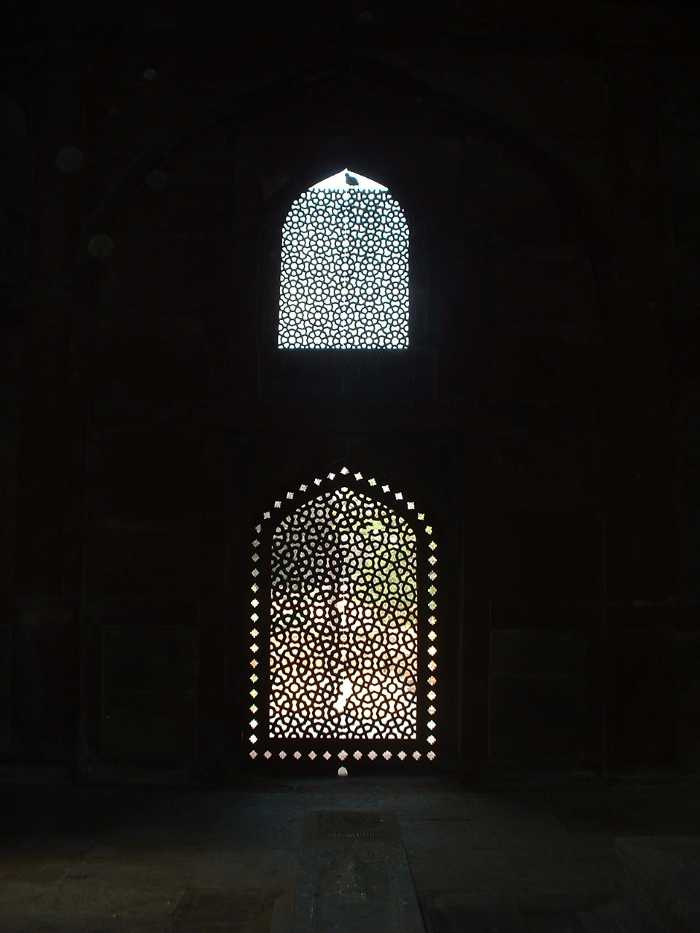FWP:
SETS == INEXPRESSIBILITY
On the nature of the rauzan , 'crevice-work', see {64,4}; the word is also used in the previous verse, {87,3}.
ABOUT the punbah-e rauzan : Why would people put cotton into such 'crevice-work'? The only commentator who explains is Naiyar Mas'ud: 'Cotton is put into the crevice-work in order
to prevent the outside light from coming inside'. (I would have guessed that it would be to protect against wind or rain, or to block the entry of small birds.) In any case, it seems to be assumed that rather large wads of raw cotton-- perhaps of the kind meant for stuffing pillows and quilts-- would be readily available in the household. (In {15,2}, a cotton pillow appears; in {211,8x}, a weaving reference, and cotton in the ears; there's also {372x,2}, with a cotton stopper for a wine-bottle; and {383x,6}, in which that cotton stopper is used as an earplug.) Other verses that link crevice-work with cotton: {33,8x}; {113,2}; {113,4}; {195,3x} // {266x,2}.
What exactly might be the relationship(s) between the cotton and the light of dawn? There seem to be three main possibilities: either (1) the white cotton impersonates the dawn; or (2) the white cotton rivals the light of day; or else (3) the cotton is as radically dark as the outside world.
(1) It is night outside, but in the cell of grief it is much blacker. So black that even the tiniest bit of whiteness looks exaggeratedly bright. If cotton is put in the crevice-work, even some tiny glimmer it might pick up from the ambient moonlight and starlight outside would make it look as bright as the white light of dawn that the sufferer awaits with such longing. (And in fact, to such darkness dawn may never come at all, so perhaps the cotton in fact is the sufferer's dawn-- all the dawn he'll ever get; on 'crack of dawn' imagery, see {67,1}.)
(2) It is morning, and there's light outside, but in the cell of grief this light remains merely notional. So little of it penetrates the dimness of the cell that it hardly makes any difference whether the crevice-work is blocked with cotton or not. The cotton seems to give a feeble, false, unhelpful glimmer-- and so does the morning sun. In fact, it's impossible to distinguish the wretched amount of 'light' that each of them provides.
(3) Night and day, the cell of grief is perpetually black; it generates its own darkness, and can never receive any 'light of dawn'. No moonlight or sunlight can penetrate into it, so the light of dawn has no effect on it whatsoever. It's so black that if you put cotton into the crevice-work-- which would normally prevent the dawn light from coming in-- it would make no difference at all, because the dawn light can't come in anyway. The light-blocking cotton is no darker than the equally dark dawn; both are powerless against the cruel, oppressive darkness of the cell of grief.
As the commentators point out, {113,4}
is a useful comparative case study. And the word andher
is of course perfectly chosen-- an altogether powerful and suitable word,
full of affinity with
other words and thoughts in the verse. For another example of the same kind
of wordplay, see {164,10}.

Nazm:
Where the darkness is great, even a very little bit of light seems to be a lot. From this we should understand how great would be the darkness in a cell in which cotton in the crevice-work resembles the whiteness of dawn. (86)
== Nazm page 86